When it comes to long-term food security, protein is one of the most crucial elements in any prepper’s stockpile. Having spent years testing various emergency food options, I’ve learned that finding shelf-stable meat that’s both nutritious and delicious can be quite a challenge.
The Good Prepper’s Canned Beef claims to be the ultimate survival meat: tasty, nutritious, and capable of lasting up to 25 years without refrigeration. But does it live up to these claims? Let’s take a detailed look at what makes this product different from standard grocery store options.
What Sets This Apart From Regular Canned Meat?
After examining and testing this product, several key features stand out. First and foremost is the quality of ingredients and processing. Unlike most commercial canned meats that contain preservatives, fillers, and mystery ingredients, The Good Prepper keeps it remarkably simple: just beef and sea salt. The meat comes from small American family farms where cattle are raised without antibiotics or hormones. It’s processed in a fourth-generation facility in Ohio using traditional methods that preserve both nutrition and flavor.
What really caught my attention is their unique preservation method. Instead of pre-cooking the meat and then canning it (which can lead to that mushy texture we all know from grocery store options), they seal the raw beef first, then slow-pressure cook it at 240 degrees in small batches. This process locks in the natural juices and nutrients while eliminating harmful bacteria without artificial preservatives. The result is a significantly better texture than mass-produced alternatives and an impressive shelf life without compromising quality.
The packaging shows serious attention to detail with heavy-duty American-made steel cans (not cheap aluminum). There’s no plastic lining that could leach chemicals, and they use a custom “DentGuardBox” for shipping protection. Even the packaging is discreet to maintain your privacy.
Real-World Performance
I’ve tested this beef in various preparation methods, from straight out of the can to incorporating it into more complex recipes. The taste and texture stand out immediately. It’s not overly salty like most canned meats, and it maintains a natural, home-cooked texture. There’s no gristle or mystery bits, and it’s versatile enough for everything from sandwiches to stews.
Ex-Special Forces survival expert Tyler White, who has trained hundreds in primitive survival skills, shares my assessment: “A true explosion of lip-smacking flavor with high-quality cuts of beef. No fat, no bone, no grizzle. Seasoned with just a few pinches of sea salt and cooked to perfection. Ready to eat right out of the can or warmed up, offering a simple, delicious solution even in the toughest of times.” he stated.
What makes this particularly valuable for preppers is its practical application in emergency scenarios. There’s no rehydration needed, which saves precious water resources. It’s ready to eat without cooking and requires no refrigeration. Most importantly, it offers a genuine 25-year shelf life when properly stored.
Price VS. Value Analysis
Now, for the elephant in the room “The Price”: At $389 for a case, I know this may not look cheap. However, here’s what experienced preppers understand about long-term food storage: grocery store canned meat runs $3-4 per serving with only a 2-3 year shelf life, while premium freeze-dried meat costs $7-10 per serving and requires water. The Good Prepper Beef, at $6.50 per serving with a 25-year shelf life, offers solid value when you consider the extended storage capability and no need for water preparation. What proper storage mean? Store in a cool, dark location out of direct sunlight and you should get a great shelf-life.
As Jason H., another experienced prepper notes: “It’s an excellent source of protein, it’s a clean product, it doesn’t have additives, it will last up to 25 years and it will be ready when you have a stressful or emergency situation when you need good food. This is an excellent product, I strongly recommend it.”
Final Thoughts:
After thorough testing and analysis, The Good Prepper Canned Beef proves to be a premium option for serious preppers who prioritize quality and long-term storage capability. While the initial investment might seem steep, the peace of mind knowing you have quality, shelf-stable protein is worth considering for your preparedness strategy. It serves as bug-out food, long-term storage protein, and a major part of your emergency vehicle kit supplies. However, it might not be your best choice for short-term emergency food rotation or budget-conscious prepping.
James W., a verified buyer, can’t seem to contain his excitement in his review of The Good Prepper Beef that goes: “Oh my God this smells and tastes so good. I like that they don’t over-salt it. The only downside is having enough to go around because everybody will want to scarf it down. Super simple, super nutritious, quality shelf life, no brainer.”
The bottom line: If you’re serious about food security and want a premium protein option that will last decades, The Good Prepper Canned Beef is worth considering. Just ensure you have proper storage conditions to maximize its shelf life potential. Remember, your food storage is only as good as its weakest link. Having reliable protein sources could make the difference between surviving and thriving in a crisis situation.


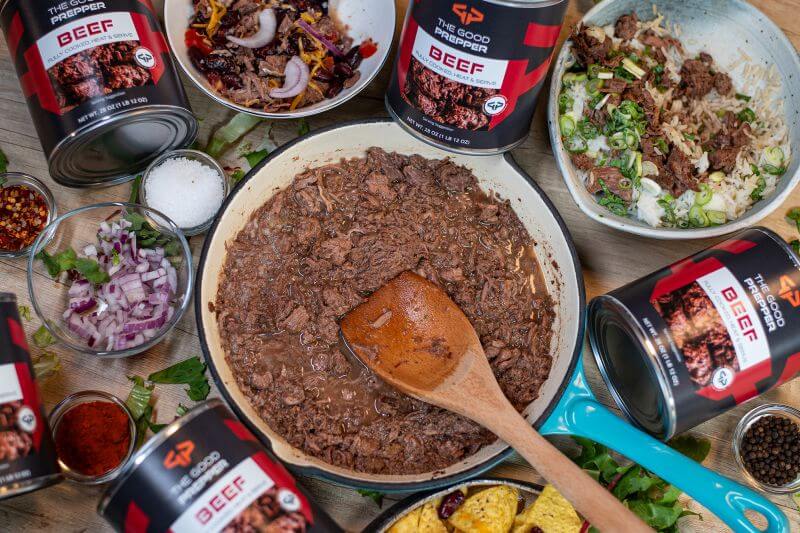
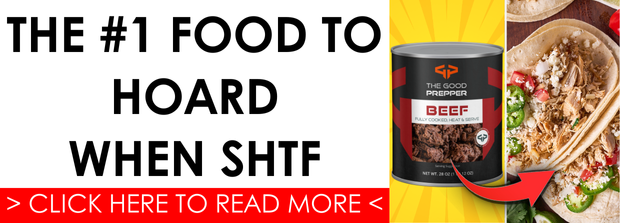
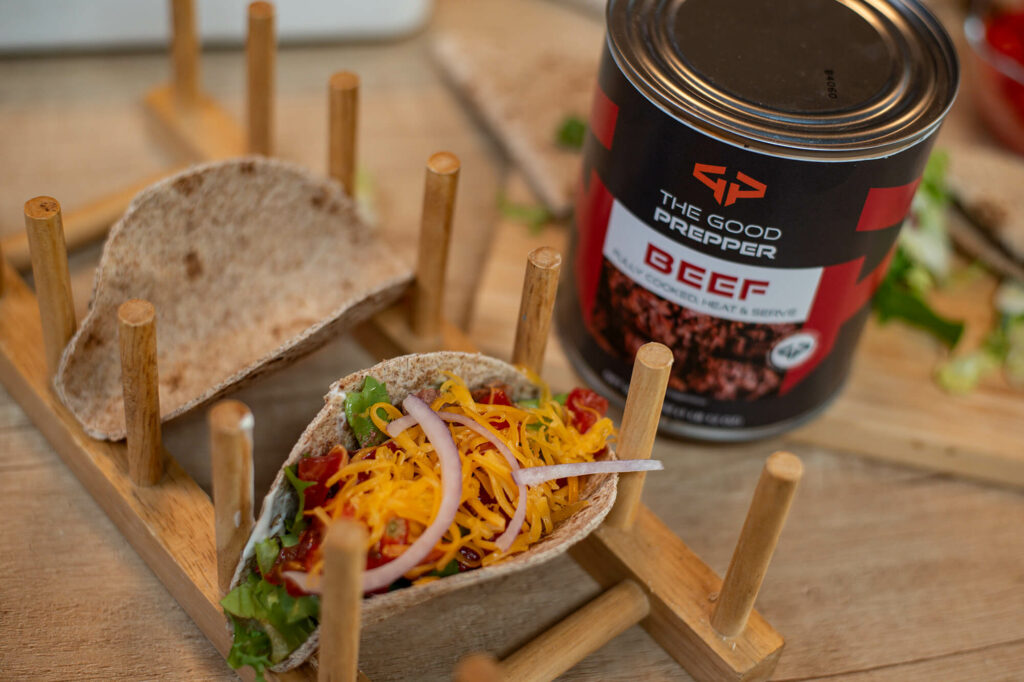
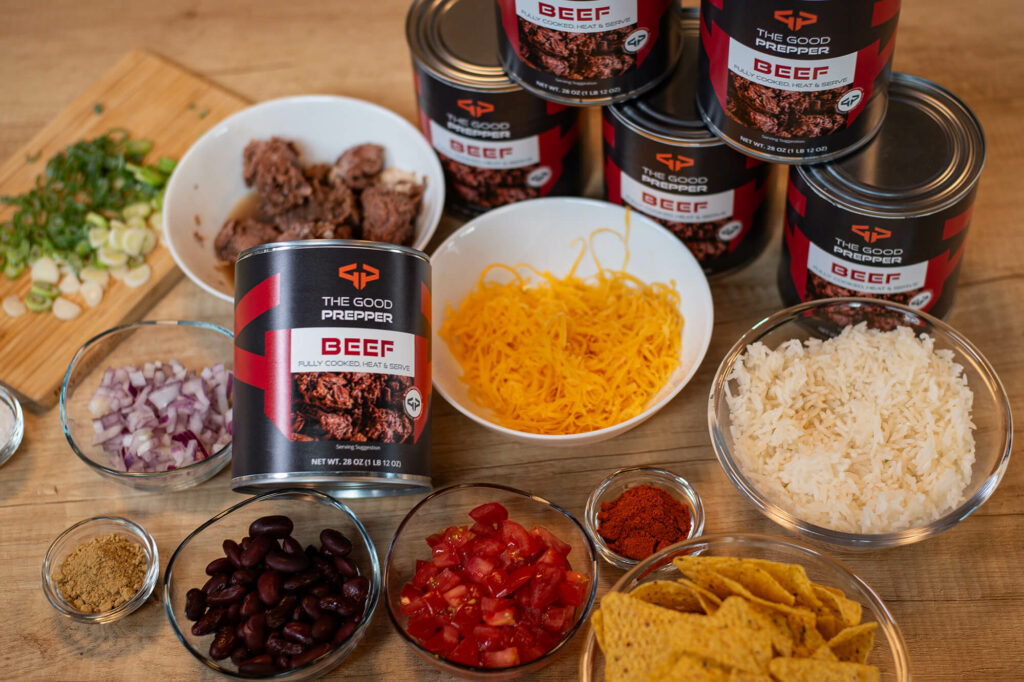
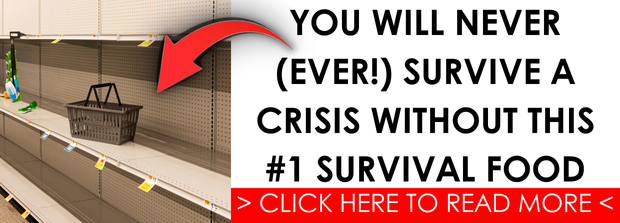
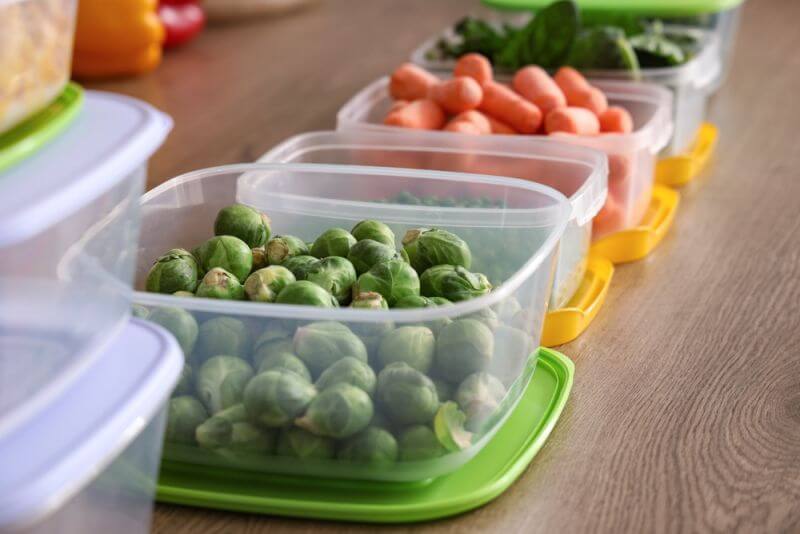




Susan Schmitt | February 13, 2025
|
How many cans are in a case? $389.00 divided by $6.50 is about 60 cans. That can’t be right.
Daniel Pease | February 13, 2025
|
The article says $6.50 per “serving”, not can. If it is like a similar product, it is 28oz per can, 12 cans per case. Serving size at that price would be 5.6 oz.
Sabina from Survivopedia | February 14, 2025
|
Hello, we had a typo, now we have the right information. So it’s 6.5$ per serving, 389$ per 1 case of 12 cans, saving 60$ 🙂
Sabina from Survivopedia | February 14, 2025
|
Hello, Susan. There are 12 cans per case. That’s 60 servings at 389$, saving 60$ 🙂 We had a typo, you were right!
Frank Cestroni | February 13, 2025
|
I was brought up in a working-class family and worked most of my life. Even when times were hard, we had good wholesome food. And we were taught when possible – quality over quantity, but this. One case at $389.00, for 12 cans @28 oz. each, comes to about $32.42 per-can.
I’m not rich and being medically retired. This seems to be more of a luxury item. I can put what little I have to better use elsewhere.
Tho. I might have missed it; What is the shelf life of this product, again?
Sabina from Survivopedia | February 14, 2025
|
Hello, Frank. With proper storage, it has an impressive shelf life of up to 25 years, making it an ideal choice for long-term food storage.
JESS | April 12, 2025
|
You can pressure can your own jars of quality or even organically raised beef for less than that! My guess is $10-12 a 3 cup jar, which would be 24 oz. I do this all the time. Maybe wouldn’t last 25 years, but hopefully, we will have used it by 3-4 years and rotated the new jars in and the old ones out. Pressure canning meat is SO EASY. i just start with quality raw meat and a 1/4-1/2 tspn. of sea salt and a bit of broth or water, and pressure can it. Raw meat slides right into the jars, so VERY EASY! You just know how to pressure can safely, and wha-lah, it’s done just the way you want it. Chicken Breast, Turkey, Beef roasts or Venison, of Beef or Venison Stew Chunks, Lamb in any form, Ground Beef, Ham, almost any kind of meat! So EASY and so much cheaper!@!
Also, I keep a close eye on Lehman’s buy one-get one cans of beef. That almost makes it worth the expense!! I always keep an eye out for meats that are preservative free, because the nitrates and nitrities and even red food coloring trigger A-Fib for many.
Arthur McBride Block | February 13, 2025
|
The real elephant in the room is: WHAT ARE THE CORRECT STORAGE CONDITIONS TOI MAINTAIN THE SHELF LIFE OF 25 YEARS as claimed in these endorsements?
Sabina from Survivopedia | February 14, 2025
|
Hello, Arthur. Proper storage: Store in a cool, dark location out of direct sunlight and you should get a shelf-life of up to 25 years
William F Fraser | February 13, 2025
|
Thats $32.41 per can 12 cans in a case
Sabina from Survivopedia | February 14, 2025
|
William, you are right. The offer is 389$ for 1 case with 12 cans, saving 60$ 🙂
Sasha | February 14, 2025
|
We live in Florida. What qualifies as a cool, dry place?
Sabina from Survivopedia | February 18, 2025
|
In Florida’s hot and humid climate, a cool, dry place is typically an area that meets these conditions: bellow 24°C, away from direct sunlight and heat sources, below 50% relative humidity is best. Maybe use a pantry or cabinet away from the stove and sink or a drawer or storage bin with silica gel packs to absorb excess moisture and keep the food dry.
Albert J.K. | April 12, 2025
|
Price per can may seem high, But when worked out it is no more than going to a burger joint and getting one from them. Just a burger around here is going for around $5.00 each. So cost here is not bad just that you are getting a case..
Mark Amato | April 12, 2025
|
This is way to much money for the average prepper to expense. Lets get real ! How about selling individual cans at less cost.
Frank C | April 13, 2025
|
This ‘Good Prepper brand’, might be a good product, but the cost is ridicules. I just bought several cans of Canned Meat from Walmart of all places. The product is from “Keystone” made in Ohio, USA; All natural- with only meat, salt & water: 28 oz. cans. And they have a variety: Beef, Ground Beef, Pork, Turkey and Chicken, all with no preservatives… Each can, sold for under $10.00 each. That’s a savings of over $20.00 dollars per-can.
And last night I made pork tacos, with refried black beans, onions and peppers, with cheddar cheese & salsa on top… It tasted great!!! Even my brother had seconds. Last month, it was the Beef. There weren’t any leftovers. All you need is a little heat and seasoning for your taste.
The problem I see here, is someone is focusing their brand to a specific type of people and jacking up their price.
Or are they relabeling the cans… Where is ‘Good Prepper’ Brand made???
I am not trying to be a NAY sayer, against this product, but there are products out there that don’t cost a lot and are (or might) be just as good.
Don’t dwell on the “END of TIMES” and forget to live. Just be prepared & ready.
Shya | April 16, 2025
|
Thanx, you saved me a ton of typing, I was about to say the same thing.
This stuff is available all over the place recently, all seems to be the same product, relabeled and marked up significantly.
Good to see someone else sharing the bigger picture for those not quite as well informed. Kudos to you.